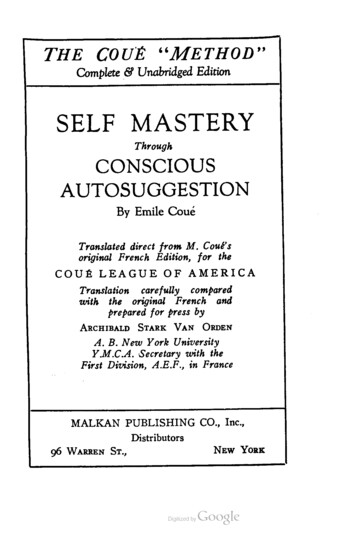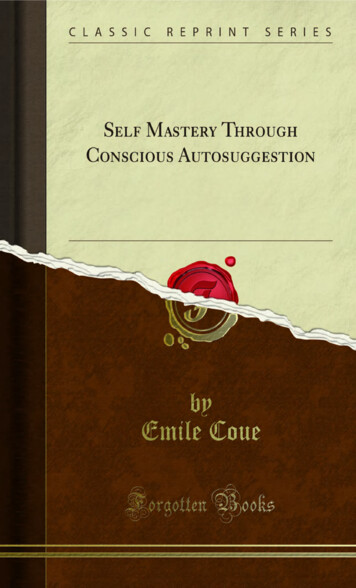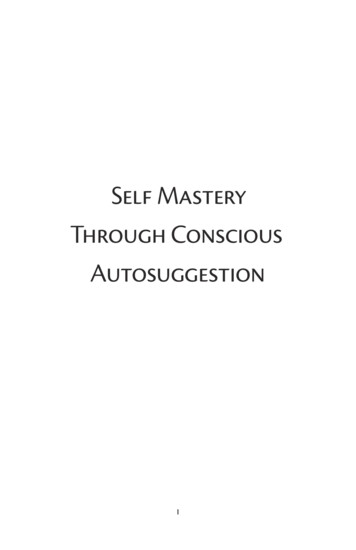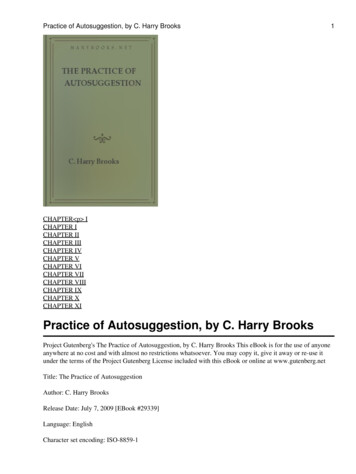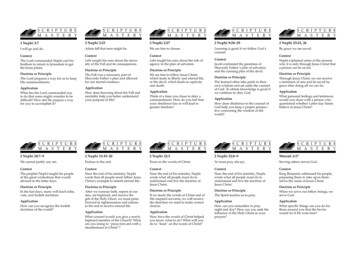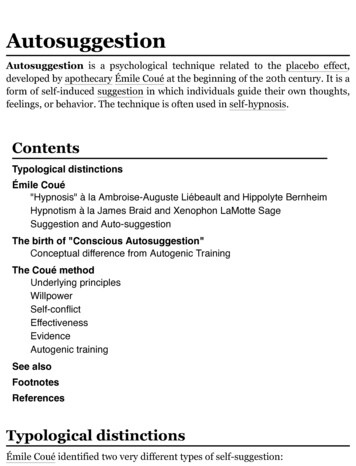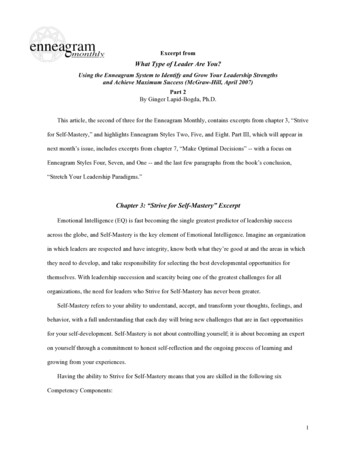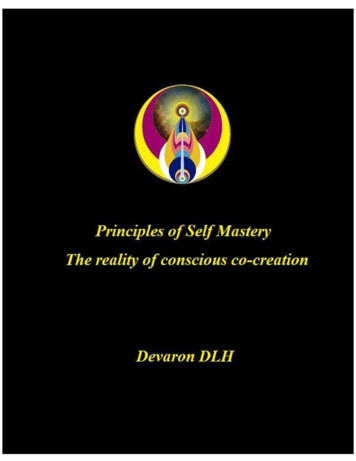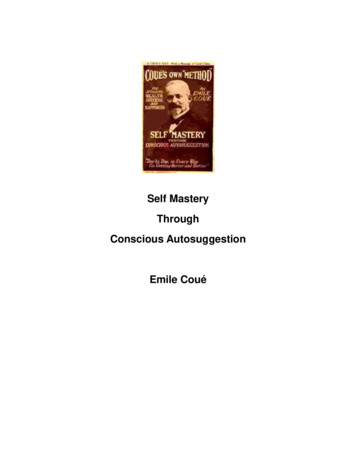
Transcription
Self MasteryThroughConscious AutosuggestionEmile Coué
Table of Contents1. Introduction2. The Conscious Self And The Unconscious Self3. Will And Imagination4. Suggestion And Autosuggestion5. The Use Of Autosuggestion6. How To Teach Patients To Make Autosuggestion7. Method Of Procedure In Curative Suggestion8. The Superiority Of This Method9. How Suggestion Works10. The Use Of Suggestion For The Cure Of Moral Ailments And Taints11. A Few Typical Cures12. Conclusion
IntroductionSuggestion, or rather Autosuggestion, is quite a new subject, andyet at the same time it is as old as the world.It is new in the sense that until now it has been wrongly studiedand in consequence wrongly understood; it is old because it datesfrom the appearance of man on the earth. In fact autosuggestionis an instrument that we possess at birth, and in this instrument,or rather in this force, resides a marvelous and incalculable power,which according to circumstances produces the best or the worstresults. Knowledge of this force is useful to each one of us, but itis peculiarly indispensable to doctors, magistrates, lawyers, and tothose engaged in the work of education.By knowing how to practise it consciously it is possible in the firstplace to avoid provoking in others bad autosuggestions which mayhave disastrous consequences, and secondly, consciously toprovoke good ones instead, thus bringing physical health to thesick, and moral health to the neurotic and the erring, theunconscious victims of anterior autosuggestions, and to guide intothe right path those who had a tendency to take the wrong one.
The Conscious Self And The Unconscious SelfChapter 1In order to understand properly the phenomena of suggestion, orto speak more correctly of autosuggestion, it is necessary to knowthat two absolutely distinct selves exist within us. Both areintelligent, but while one is conscious the other is unconscious. Forthis reason the existence of the latter generally escapes notice. Itis however easy to prove its existence if one merely takes thetrouble to examine certain phenomena and to reflect a fewmoments upon them. Let us take for instance the followingexamples:Every one has heard of somnambulism; every one knows that asomnambulist gets up at night without waking, leaves his roomafter either dressing himself or not, goes downstairs, walks alongcorridors, and after having executed certain acts or accomplishedcertain work, returns to his room, goes to bed again, and showsnext day the greatest astonishment at finding work finished whichhe had left unfinished the day before. It is however he himself whohas done it without being aware of it. What force has his bodyobeyed if it is not an unconscious force, in fact his unconsciousself?Let us now examine the alas, too frequent case of a drunkardattacked by delirium tremens. As though seized with madness hepicks up the nearest weapon, knife, hammer, or hatchet, as thecase may be, and strikes furiously those who are unlucky enoughto be in his vicinity. Once the attack is over, he recovers hissenses and contemplates with horror the scene of carnage aroundhim, without realizing that he himself is the author of it. Hereagain is it not the unconscious self which has caused the unhappyman to act in this way? (And what aversions, what ills we createfor ourselves, everyone of us and in every domain by not“immediately” bringing into play “good conscious autosuggestions”against our “bad unconscious autosuggestions,” thus bringingabout the disappearance of all unjust suffering.)If we compare the conscious with the unconscious self we see thatthe conscious self is often possessed of a very unreliable memory
while the unconscious self on the contrary is provided with amarvelous and impeccable memory which registers without ourknowledge the smallest events, the least important acts of ourexistence. Further, it is credulous and accepts with unreasoningdocility what it is told. Thus, as it is the unconscious that isresponsible for the functioning of all our organs but theintermediary of the brain, a result is produced which may seemrather paradoxical to you: that is, if it believes that a certain organfunctions well or ill or that we feel such and such an impression,the organ in question does indeed function well or ill, or we do feelthat impression.Not only does the unconscious self preside over the functions ofour organism, but also over all our actions whatever they are. It isthis that we call imagination, and it is this which, contrary toaccepted opinion, always makes us act even, and above all,against our will when there is antagonism between these twoforces.
Will And ImaginationChapter 2If we open a dictionary and look up the word “will”, we find thisdefinition: “The faculty of freely determining certain acts”. Weaccept this definition as true and unattackable, although nothingcould be more false. This will that we claim so proudly, alwaysyields to the imagination. It is an absolute rule that admits of noexception.“Blasphemy! Paradox!” you will exclaim. “Not at all! On thecontrary, it is the purest truth,” I shall reply.In order to convince yourself of it, open your eyes, look round youand try to understand what you see. You will then come to theconclusion that what I tell you is not an idle theory, offspring of asick brain but the simple expression of a fact.Suppose that we place on the ground a plank 30 feet long by 1foot wide. It is evident that everybody will be capable of goingfrom one end to the other of this plank without stepping over theedge. But now change the conditions of the experiment, andimagine this plank placed at the height of the towers of acathedral. Who then will be capable of advancing even a few feetalong this narrow path? Could you hear me speak? Probably not.Before you had taken two steps you would begin to tremble, andin spite of every effort of your will you would be certain to fall tothe ground.Why is it then that you would not fall if the plank is on the ground,and why should you fall if it is raised to a height above theground? Simply because in the first case you imagine that it iseasy to go to the end of this plank, while in the second case youimagine that you cannot do so.Notice that your will is powerless to make you advance; if youimagine that you cannot, it is absolutely impossible for you to doso. If tilers and carpenters are able to accomplish this feat, it isbecause they think they can do it.
Vertigo is entirely caused by the picture we make in our mindsthat we are going to fall. This picture transforms itself immediatelyinto fact in spite of all the efforts of our will, and the more violentthese efforts are, the quicker is the opposite to the desired resultbrought about.Let us now consider the case of a person suffering from insomnia.If he does not make any effort to sleep, he will lie quietly in bed. Ifon the contrary he tries to force himself to sleep by his will, themore efforts he makes, the more restless he becomes.Have you not noticed that the more you try to remember thename of a person which you have forgotten, the more it eludesyou, until, substituting in your mind the idea “I shall remember ina minute” to the idea “I have forgotten”, the name comes back toyou of its own accord without the least effort?Let those of you who are cyclists remember the days when youwere learning to ride. You went along clutching the handle barsand frightened of falling. Suddenly catching sight of the smallestobstacle in the road you tried to avoid it, and the more efforts youmade to do so, the more surely you rushed upon it.Who has not suffered from an attack of uncontrollable laughter,which bursts out more violently the more one tries to control it?What was the state of mind of each person in these differentcircumstances? “I do not want to fall but I cannot help doing so”;“I want to sleep but I cannot”; “I want to remember the name ofMrs. So and So, but I cannot”; “I want to avoid the obstacle, but Icannot”; “I want to stop laughing, but I cannot.”As you see, in each of these conflicts it is always the imaginationwhich gains the victory over the will, without any exception.To the same order of ideas belongs the case of the leader whorushes forward at the head of his troops and always carries themalong with him, while the cry “Each man for himself!” is almostcertain to cause a defeat. Why is this? It is because in the firstcase the men imagine that they must go forward, and in thesecond they imagine that they are conquered and must fly fortheir lives.
Panurge was quite aware of the contagion of example, that is tosay the action of the imagination, when, to avenge himself upon amerchant on board the same boat, he bought his biggest sheepand threw it into the sea, certain beforehand that the entire flockwould follow, which indeed happened.We human beings have a certain resemblance to sheep, andinvoluntarily, we are irresistibly impelled to follow other people‟sexamples, imagining that we cannot do otherwise.I could quote a thousand other examples but I should fear to boreyou by such an enumeration. I cannot however pass by in silencethis fact which shows the enormous power of the imagination, orin other words of the unconscious in its struggle against the will.There are certain drunkards who wish to give up drinking, but whocannot do so. Ask them, and they will reply in all sincerity thatthey desire to be sober, that drink disgusts them, but that theyare irresistibly impelled to drink against their will, in spite of theharm they know it will do them.In the same way certain criminals commit crimes in spite ofthemselves, and when they are asked why they acted so, theyanswer “I could not help it, something impelled me, it wasstronger than I.”And the drunkard and the criminal speak the truth; they are forcedto do what they do, for the simple reason they imagine theycannot prevent themselves from doing so. Thus we who are soproud of our will, who believe that we are free to act as we like,are in reality nothing but wretched puppets of which ourimagination holds all the strings. We only cease to be puppetswhen we have learned to guide our imagination.
Suggestion And AutosuggestionChapter 3According to the preceding remarks we can compare theimagination to a torrent which fatally sweeps away the poorwretch who has fallen into it, in spite of his efforts to gain thebank. This torrent seems indomitable; but if you know how, youcan turn it from its course and conduct it to the factory, and thereyou can transform its force into movement, heat, and electricity.If this simile is not enough, we may compare the imagination -“the madman at home” as it has been called -- to an unbrokenhorse which has neither bridle nor reins. What can the rider doexcept let himself go wherever the horse wishes to take him? Andoften if the latter runs away, his mad career only comes to end inthe ditch. If however the rider succeeds in putting a bridle on thehorse, the parts are reversed. It is no longer the horse who goeswhere he likes, it is the rider who obliges the horse to take himwherever he wishes to go.Now that we have learned to realize the enormous power of theunconscious or imaginative being, I am going to show how thisself, hitherto considered indomitable, can be as easily controlledas a torrent or an unbroken horse. But before going any further itis necessary to define carefully two words that are often usedwithout being properly understood. These are the wordssuggestion and autosuggestion.What then is suggestion? It may be defined as “the act ofimposing an idea on the brain of another”. Does this action reallyexist? Properly speaking, no. Suggestion does not indeed exist byitself. It does not and cannot exist except on the sine qua noncondition of transforming itself into autosuggestion in the subject.This latter word may be defined as “the implanting of an idea inoneself by oneself.”You may make a suggestion to someone; if the unconscious of thelatter does not accept the suggestion, if it has not, as it were,
digested it, in order to transform it into autosuggestion, itproduces no result. I have myself occasionally made a more orless commonplace suggestion to ordinarily very obedient subjectsquite unsuccessfully. The reason is that the unconscious of thesubject refused to accept it and did not transform it intoautosuggestion.
The Use Of AutosuggestionChapter 4Let us now return to the point where I said that we can controland lead our imagination, just as a torrent or an unbroken horsecan be controlled. To do so, it is enough in the first place to knowthat this is possible (of which fact almost everyone is ignorant)and secondly, to know by what means it can be done. Well, themeans is very simple; it is that which we have used every daysince we came into the world, without wishing or knowing it andabsolutely unconsciously, but which unfortunately for us, we oftenuse wrongly and to our own detriment. This means isautosuggestion.Whereas we constantly give ourselves unconsciousautosuggestions, all we have to do is to give ourselves consciousones, and the process consists in this: first, to weigh carefully inone‟s mind the things which are to be the object of theautosuggestion, and according as they require the answer “yes” or“no” to repeat several times without thinking of anything else:“This thing is coming”, or “this thing is going away”; “this thingwill, or will not happen, etc., etc. . . .”. (Of course, the thing mustbe in our power.) If the unconscious accepts this suggestion andtransforms it into an autosuggestion, the thing or things arerealized in every particular.Thus understood, autosuggestion is nothing but hypnotism as Isee it, and I would define it in these simple words: The influenceof the imagination upon the moral and physical being of mankind.Now this influence is undeniable, and without returning to previousexamples, I will quote a few others.If you persuade yourself that you can do a certain thing, providedthis thing be possible, you will do it however difficult it may be. Ifon the contrary you imagine that you cannot do the simplest thingin the world, it is impossible for you to do it, and molehills becomefor you unscalable mountains.
Such is the case of neurasthenics, who, believing themselvesincapable of the least effort, often find it impossible even to walk afew steps without being exhausted. And these same neurasthenicssink more deeply into their depression, the more efforts theymake to throw it off, like the poor wretch in the quicksands whosinks in all the deeper the more he tries to struggle out.In the same way it is sufficient to think a pain is going, to feel itindeed disappear little by little, and inversely, it is enough to thinkthat one suffers in order to feel the pain begin to comeimmediately.I know certain people who predict in advance that the will have asick headache on a certain day, in certain circumstances, and onthat day, in the given circumstances, sure enough, they feel it.They brought their illness on themselves, just as others cure theirsby conscious autosuggestion.I know that one generally passes for mad in the eyes of the worldif one dares to put forward ideas which it is not accustomed tohear. Well, at the risk of being thought so, I say that if certainpeople are ill mentally and physically, it is that they imaginethemselves to be ill mentally or physically. If certain others areparalytic without having any lesion to account for it, it is that theyimagine themselves to be paralyzed, and it is among such personsthat the most extraordinary cures are produced. If others againare happy or unhappy, it is that they imagine themselves to be so,for it is possible for two people in exactly the same circumstancesto be, the one perfectly happy, the other absolutely wretched.Neurasthenia, stammering, aversions, kleptomania, certain casesof paralysis, are nothing but the, result of unconsciousautosuggestion, that is to say the result of the action of theunconscious upon the physical and moral being.But if our unconscious is the source of many of our ills, it can alsobring about the cure of our physical and mental ailments. It cannot only repair the ill it has done, but cure real illnesses, so strongis its action upon our organism.Shut yourself up alone in a room, seat yourself in an armchair,close your eyes to avoid any distraction, and concentrate your
mind for a few moments on thinking: “Such and such a thing isgoing to disappear”, or “Such and such a thing is coming to pass.”If you have really made the autosuggestion, that is to say, if yourunconscious has assimilated the idea that you have presented toit, you are astonished to see the thing you have thought come topass. (Note that it is the property of ideas auto-suggested to existwithin us unrecognized, and we can only know of their existenceby the effect they produce.) But above all, and this is an essentialpoint, the will must not be brought into play in practisingautosuggestion; for, if it is not in agreement with theimagination, if one thinks: “I will make such and such a thinghappen”, and the imagination says: “You are willing it, but it is notgoing to be”, not only does one not obtain what one wants, buteven exactly the reverse is brought about.This remark is of capital importance, and explains why results areso unsatisfactory when, in treating moral ailments, one strives tore-educate the will. It is the training of the imagination which isnecessary, and it is thanks to this shade of difference that mymethod has often succeeded where others -- and those not theleast considered -- have failed. From the numerous experimentsthat I have made daily for twenty years, and which I haveexamined with minute care, I have been able to deduct thefollowing conclusions which I have summed up as laws:When the will and the imagination are antagonistic, it is alwaysthe imagination which wins, without any exception.In the conflict between the will and the imagination, the force ofthe imagination is in direct ratio to the square of the will.When the will and the imagination are in agreement, one does notadd to the other, but one is multiplied by the other.The imagination can be directed.(The expressions “In direct ratio to the square of the will” and “Ismultiplied by” are not rigorously exact. They are simplyillustrations destined to make my meaning clearer.)
After what has just been said it would seem that nobody ought tobe ill. That is quite true. Every illness, whatever it may be, canyield to autosuggestion, daring and unlikely as my statement mayseem; I do not say does always yield, but can yield, which is adifferent thing.But in order to lead people to practise conscious autosuggestionthey must be taught how, just as they are taught to read or writeor play the piano.Autosuggestion is, as I said above, an instrument that we possessat birth, and with which we play unconsciously all our life, as ababy plays with its rattle. It is however a dangerous instrument; itcan wound or even kill you if you handle it imprudently andunconsciously. It can on the contrary save your life when youknow how to employ it consciously. One can say of it as Aesopsaid of the tongue: “It is at the same time the best and the worstthing in the world”.I am now going to show you how everyone can profit by thebeneficent action of autosuggestion consciously applied. In saying“every one”, I exaggerate a little, for there are two classes ofpersons in whom it is difficult to arouse conscious autosuggestion:The mentally undeveloped who are not capable of understandingwhat you say to them.Those who are unwilling to understand.
How To Teach Patients To Make AutosuggestionChapter 5The principle of the method may be summed up in these fewwords: It is impossible to think of two things at once, that is to saythat two ideas may be in juxtaposition, but they cannot besuperimposed in our mind.Every thought entirely filling our mind becomes true for us andtends to transform itself into action.Thus if you can make a sick person think that her trouble isgetting better, it will disappear; if you succeed in making akleptomaniac think that he will not steal any more, he will cease tosteal, etc., etc.This training which perhaps seems to you an impossibility, is,however, the simplest thing in the world. It is enough, by a seriesof appropriate and graduated experiments, to teach the subject,as it were the A. B. C. of conscious thought, and here is theseries: by following it to the letter one can be absolutely sure ofobtaining a good result, except with the two categories of personsmentioned above.First experiment(These experiments are those of Sage of Rochester.) Preparatory.-- Ask the subject to stand upright, with the body as stiff as aniron bar, the feet close together from toe to heel, while keepingthe ankles flexible as if they were hinges. Tell him to make himselflike a plank with hinges at its base, which is balanced on theground. Make him notice that if one pushes the plank slightlyeither way it falls as a mass without any resistance, in thedirection in which it is pushed. Tell him that you are going to pullhim back by the shoulders and that he must let himself fall in yourarms without the slightest resistance, turning on his ankles as onhinges, that is to say keeping the feet fixed to the ground. Thenpull him back by the shoulders and if the experiment does notsucceed, repeat it until it does, or nearly so.
Second experimentBegin by explaining to the subject that in order to demonstrate theaction of the imagination upon us, you are going to ask him in amoment to think: “I am falling backwards, I am falling backwards. . .” Tell him that he must have no thought but this in his mind,that he must not reflect or wonder if he is going to fall or not, orthink that if he falls he may hurt himself, etc., or fall backpurposely to please you, but that if he really feels somethingimpelling him to fall backwards, he must not resist but obey theimpulse.Then ask your subject to raise the head high and to shut his eyes,and place your right fist on the back of his neck, and your lefthand on his forehead, and say to him: “Now think: I am fallingbackwards, I am falling backwards, etc., etc. . . “ and, indeed,“You are falling backwards, You . . . are. . . fall . . . ing . . . back . . wards, etc.” At the same time slide the left hand lightlybackwards to the left temple, above the ear, and remove veryslowly but with a continuous movement the right fist.The subject is immediately felt to make a slight movementbackwards, and either to stop himself from falling or else to fallcompletely. In the first case, tell him that he has resisted, and thathe did not think just that he was falling, but that he might hurthimself if he did fall. That is true, for if he had not thought thelatter, he would have fallen like a block. Repeat the experimentusing a tone of command as if you would force the subject to obeyyou. Go on with it until it is completely successful or very nearlyso. The operator should stand a little behind the subject, the leftleg forward and the right leg well behind him, so as not to beknocked over by the subject when he falls. Neglect of thisprecaution might result in a double fall if the person is heavy.Third experimentPlace the subject facing you, the body still stiff, the ankles flexible,and the feet joined and parallel. Put your two hands on histemples without any pressure, look fixedly, without moving theeyelids, at the root of his nose, and tell him to think: “I am fallingforward, I am falling forward . . . “ and repeat to him, stressing
the syllables, “You are fall . . . ing . . . for . . . ward, You are fall . . ing . . . for . . . ward . . .” without ceasing to look fixedly at him.Fourth experimentAsk the subject to clasp his hands as tight as possible, that is tosay, until the fingers tremble slightly, look at him in the same wayas in the preceding experiment and keep your hands on his asthough to squeeze them together still more tightly. Tell him tothink that he cannot unclasp his fingers, that you are going tocount three, and that when you say “three” he is to try to separatehis hands while thinking all the time: “I cannot do it, I cannot do it. . . “ and he will find it impossible.Then count very slowly, “one, two, three”, and add immediately,detaching the syllables: “You . . . can . . . not . . . do . . . it . . . .You . . . can . . . not . . . do . . . it . . .” If the subject is thinkingproperly, “I cannot do it”, not only is he unable to separate hisfingers, but the latter clasp themselves all the more tightlytogether the more efforts he makes to separate them. He obtainsin fact exactly the contrary to what he wants. In a few momentssay to him: “Now think: „I can do it,‟” and his fingers will separatethemselves.Be careful always to keep your eyes fixed on the root of thesubject‟s nose, and do not allow him to turn his eyes away fromyours for a single moment. If he is able to unclasp his hands, donot think it is your own fault, it is the subject‟s, he has notproperly thought: “I cannot”. Assure him firmly of this, and beginthe experiment again.Always use a tone of command which suffers no disobedience. I donot mean that it is necessary to raise your voice; on the contraryit is preferable to employ the ordinary pitch, but stress every wordin a dry and imperative tone.When these experiments have been successful, all the otherssucceed equally well and can be easily obtained by carrying out tothe letter the instructions given above.Some subjects are very sensitive, and it is easy to recognize themby the fact that the contraction of their fingers and limbs is easily
produced. After two or three successful experiments, it is nolonger necessary to say to them: “Think this”, or “think that”; Youneed only, for example, say to them simply -- but in theimperative tone employed by all good suggestionists -- “Closeyour hands; now you cannot open them”. “Shut your eyes; nowyou cannot open them,” and the subject finds it absolutelyimpossible to open the hands or the eyes in spite of all his efforts.Tell him in a few moments: “You can do it now,” and the decontraction takes place instantaneously.These experiments can be varied to infinity. Here are a few more:Make the subject join his hands, and suggest that they are weldedtogether; make him put his hand on the table, and suggest that itis stuck to it; tell him that he is fixed to his chair and cannot rise;make him rise, and tell him he cannot walk; put a penholder onthe table and tell him that it weighs a hundredweight, and that hecannot lift it, etc., etc.In all these experiments, I cannot repeat too often, it is notsuggestion properly so-called which produces the phenomena, butthe autosuggestion which is consecutive to the suggestion of theoperator.
Method Of Procedure In Curative SuggestionChapter 6When the subject has passed through the preceding experimentsand has understood them, he is ripe for curative suggestion. He islike a cultivated field in which the seed can germinate anddevelop, whereas before it was but rough earth in which it wouldhave perished.Whatever ailment the subject suffers from, whether it is physicalor mental, it is important to proceed always in the same way, andto use the same words with a few variations according to the case.Say to the subject: “Sit down and close your eyes. I am not goingto try and put you to sleep as it is quite unnecessary. I ask you toclose your eyes simply in order that your attention may not bedistracted by the objects around you. Now tell yourself that everyword I say is going to fix itself in your mind, and be printed,engraved, and encrusted in it, that, there, it is going to stay fixed,imprinted, and encrusted, and that without your will or knowledge,in fact perfectly unconsciously on your part, you yourself and yourwhole organism are going to obey.In the first place I say that every day, three times a day, in themorning, at midday, and in the evening, at the usual meal times,you will feel hungry, that is to say, you will experience theagreeable sensation which makes you think and say: “Oh! hownice it will be to have something to eat!” You will then eat andenjoy your food, without of course overeating. You will also becareful to masticate it properly so as to transform it into a sort ofsoft paste before swallowing it. In these conditions you will digestit properly, and so feel no discomfort, inconvenience, or pain ofany kind either in the stomach or intestines. You will assimilatewhat you eat and your organism will make use of it to make blood,muscle, strength and energy, in a word: Life.“Since you will have digested your food properly, the function ofexcretion will be normal, and every morning, on rising, you will
feel the need of evacuating the bowels, and without ever beingobliged to take medicine or to use any artifice, you will obtain anormal and satisfactory result.“Further, every night from the time you wish to go to sleep till thetime you wish to wake next morning, you will sleep deeply, calmly,and quietly, without nightmares, and on waking you will feelperfectly well, cheerful, and active.“Likewise, if you occasionally suffer from depression, if you aregloomy and prone to worry and look on the dark side of things,from now onwards you will cease to do so, and, instead ofworrying and being depressed and looking on the dark side ofthings, you are going to feel perfectly cheerful, possibly withoutany special reason for it, just as you used to feel depressed for noparticular reason. I say further still, that even if you have realreason to be worried and depressed you are not going to be so.“If you are also subject to occasional fits of impatience or illtemper you will cease to have them: on the contrary you will bealways patient and master of yourself, and the things whichworried, annoyed, or irritated you, will henceforth leave youabsolutely indifferen
4. Suggestion And Autosuggestion 5. The Use Of Autosuggestion 6. How To Teach Patients To Make Autosuggestion 7. Method Of Procedure In Curative Suggestion 8. The Superiority Of This Method 9. How Suggestion Works 10. The Use Of Suggestion For The Cure Of Moral Ailments And Taints 11. A Few Typical Cures 12. Conclusion

